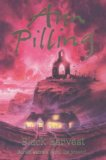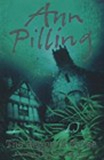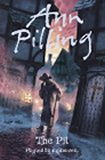
 The Witch of Lagg by Ann Pilling
The Witch of Lagg by Ann Pilling
Ann Pilling, who also goes by the alias Ann Cheatham or Lillian Cheatham, is an author with a great interest in taking historical events and folk-legends and bringing them into the present day. She has done this for the two other books concerning Oliver, Colin and Prill, Black Harvest and The Beggar’s Curse — with her three contemporary kids finding themselves caught up in the unquiet remnants of the past. In The Witch of Lagg, the author again takes historical fact and reshapes it to fit her creepy supernatural story. In her afterword she recounts the facts concerning the death of Margaret Wilson, considered one of the most tragic martyrs in Scottish history. Found guilty of heresy, she was tied to a stake upon the shore and drowned by the oncoming tide.
The author tinkers with this tale, and has her two siblings Colin and Prill (short for Priscilla) and their adopted cousin Oliver travel with their father and bossy aunt to Lagg Castle in Scotland, so that their father might paint a portrait of the owner Hugo Grierson. Also with them is their little sister Alison and their beloved Irish setter Jessie. It begins as the three children help fourteen year old Duncan Ross remove stones from a cottage cairn in order to rebuild a broken wall. Duncan and his father Angus have lived on the land all their lives, as have countless generations, but the relationship between themselves and their employer Mr Grierson is based on scorn, superiority and hatred. Both are as bad as each other, with Mr Grierson treating them as little more than dogs, whilst the Rosses fester in their own bitterness.
But when they remove the stones and uncover the old well underneath, a malevolent force is realised into the valley. Accidents happen, Jessie becomes ill, Colin has a terrible headache, and horrible pranks are played by an unseen assailant. And yet despite this, often Prill feels a gentle, loving presence — almost holy in its innate sense of goodness. Whilst the tension between the Rosses and Grierson escalates, the three children explore the beautiful countryside for clues as to what’s going on, finding bits and pieces of legends and relics that point to a long-ago crime which still lingers in Lagg.
Pilling, or Cheatham, or whatever you’d like to call her, is a master at spooky atmospheres and a foreboding sense of evil. Just as horror movies are always more scary when the terrors are left up to your imagination, Pilling carefully displays the unnaturalness of the situations without telling us exacting what’s happening. This is put to best effect when aunt Phyllis is babysitting Alison and is targeted by the malevolent presence. There’s only so much you can blame on a toddler. Her style however, is often a little confusing. Although it’s not so much the case in this book, she sometimes leaves too much to the imagination, as often it’s difficult to really grasp what’s going on. As I said, it’s not so apparent in The Witch of Lagg — she ends up spelling things out pretty clearly — but the story in which she uses this technique the most (The Beggar’s Curse) is in fact the best one.
Also of note is the wonderful character that Pilling creates in Oliver. He’s annoying, shrimpy, whiny and somewhat snivelling — yet Pilling infuses him with an insightfulness and intelligence that makes him endlessly fascinating. As she puts it, he doesn’t just see things, but beyond things, and in all three books is always the first to figure out what’s going on. He’s a great creation, and as nice as Colin and Prill are, they aren’t half as interesting as Oliver is. His adoptive mother Phyllis is an amusing stereotype of a bossy matriarch (who actually pours the children’s milk on their cereal for them) and the opposing forces in the story are vividly created as they push up against each other.
A word of warning though, for any New-Age or practicing Wiccan/witch — this book uses the medieval concept of a witch in the course of the story; defined by evil powers and links to the devil, all of which can get a little scary at times (i.e., the church itself is attacked). Just so you know.
This commentary on good and evil is another recommendation for the book, especially in humanity’s inability to forgive and forget, even several generations later, and the need for many of us to simply let go of any hate we might carry. The Witch of Lagg is a reasonably short novel, but an interesting one and a good place to start if you want to try out Pilling’s unique ideas and style. Try also the aforementioned Black Harvest and The Beggar’s Curse also featuring Oliver, Colin and Prill, as well as The Empty Frame, which uses different children but nevertheless is remarkably similar in content to the other three books.
Colin, Prill, & Oliver — (1983-2000) Ages 9-12. These stories stand alone. Publisher: Colin and Prill are on holiday in Ireland, but from the moment they arrive, Colin feels sick from an awful smell and Prill is visited by a strange creature in her dreams. Their “odd” cousin Oliver links the horror with the terrible famine in Ireland in 1840 and he must save himself and his cousins.







so you're saying I should read it? :)
As a native New Yorker, I love the idea of the city being filled with canals and no skyscrapers! And…
How did I miss this? Thanks for bringing it to my attention!
I guess that is true, Marion. And when it comes to "You Only Live Twice," I saw the movie TWICE…
You managed to work in your two loves; vintage fiction and films!